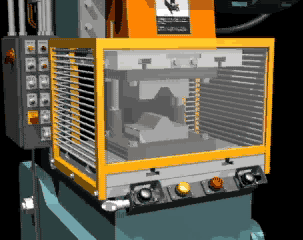
Stamping press
Encyclopedia

Metalworking
Metalworking is the process of working with metals to create individual parts, assemblies, or large scale structures. The term covers a wide range of work from large ships and bridges to precise engine parts and delicate jewelry. It therefore includes a correspondingly wide range of skills,...
machine tool
Machine tool
A machine tool is a machine, typically powered other than by human muscle , used to make manufactured parts in various ways that include cutting or certain other kinds of deformation...
used to shape or cut metal
Stamping (metalworking)
Stamping includes a variety of sheet-metal forming manufacturing processes, such as punching using a machine press or stamping press, blanking, embossing, bending, flanging, and coining. This could be a single stage operation where every stroke of the press produce the desired form on the sheet...
by deforming it with a die
Die (manufacturing)
A die is a specialized tool used in manufacturing industries to cut or shape material using a press. Like molds, dies are generally customized to the item they are used to create...
.
Bolster plate
The bolster plate (or bed) is a large block of metalMetal
A metal , is an element, compound, or alloy that is a good conductor of both electricity and heat. Metals are usually malleable and shiny, that is they reflect most of incident light...
upon which the bottom portion of a die is clamped; the bolster plate is stationary. Large presses (like the ones used in the automotive industry
Automotive industry
The automotive industry designs, develops, manufactures, markets, and sells motor vehicles, and is one of the world's most important economic sectors by revenue....
) have a die cushion integrated in the bolster plate to apply blank holder forces. This is necessary when a single acting press is used for deep drawing. The ram is also a solid piece of metal that is clamped to the top portion of a (progressive) stamping die and provides the stroke (up and down movement). This action causes the die to produce parts from the metal being fed through it.
Ram
Stamping presses can be subdivided into mechanically driven presses and hydraulicallyHydraulic ram
A hydraulic ram, or hydram, is a cyclic water pump powered by hydropower. It functions as a hydraulic transformer that takes in water at one "hydraulic head" and flow-rate, and outputs water at a higher hydraulic-head and lower flow-rate...
driven presses.
The most common mechanical presses use an eccentric drive to move the press's ram, whereas hydraulic cylinders are used in hydraulic presses. The nature of drive system determines the force progression during the ram's stroke. The advantage of the hydraulic press is the constant press force during the stroke. Mechanical presses have a press force progression towards the bottom dead center depending on the drive and hinge system. Mechanical presses therefore can reach higher cycles per unit of time and are usually more common in industrial press shops.
Another classification is single-acting presses versus double- (seldom triple) acting presses. Single-acting presses have one single ram. Double-acting presses have a subdivided ram, to manage, for example, blank holding (to avoid wrinkles) with one ram segment and the forming operation with the second ram segment.
Other components
Typically, presses are electronically linked (with a programmable logic controllerProgrammable logic controller
A programmable logic controller or programmable controller is a digital computer used for automation of electromechanical processes, such as control of machinery on factory assembly lines, amusement rides, or light fixtures. PLCs are used in many industries and machines...
) to an automatic feeder which feeds metal raw material through the die. The raw material is fed into the automatic feeder after it has been unrolled from a coil and put through a straightener. A tonnage monitor
Tonnage monitor
A tonnage monitor is a meter used on a stamping press to measure the force applied by the ram. In a press, the cutting and forming tools in the die will wear down, requiring increasing effort to stamp the part. A tonnage monitor allows the user to observe this degradation and decide when it is...
may be provided to observe the amount of force used for each stroke.

